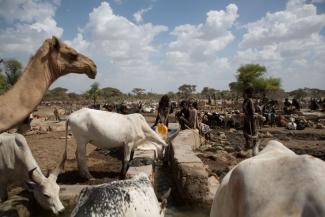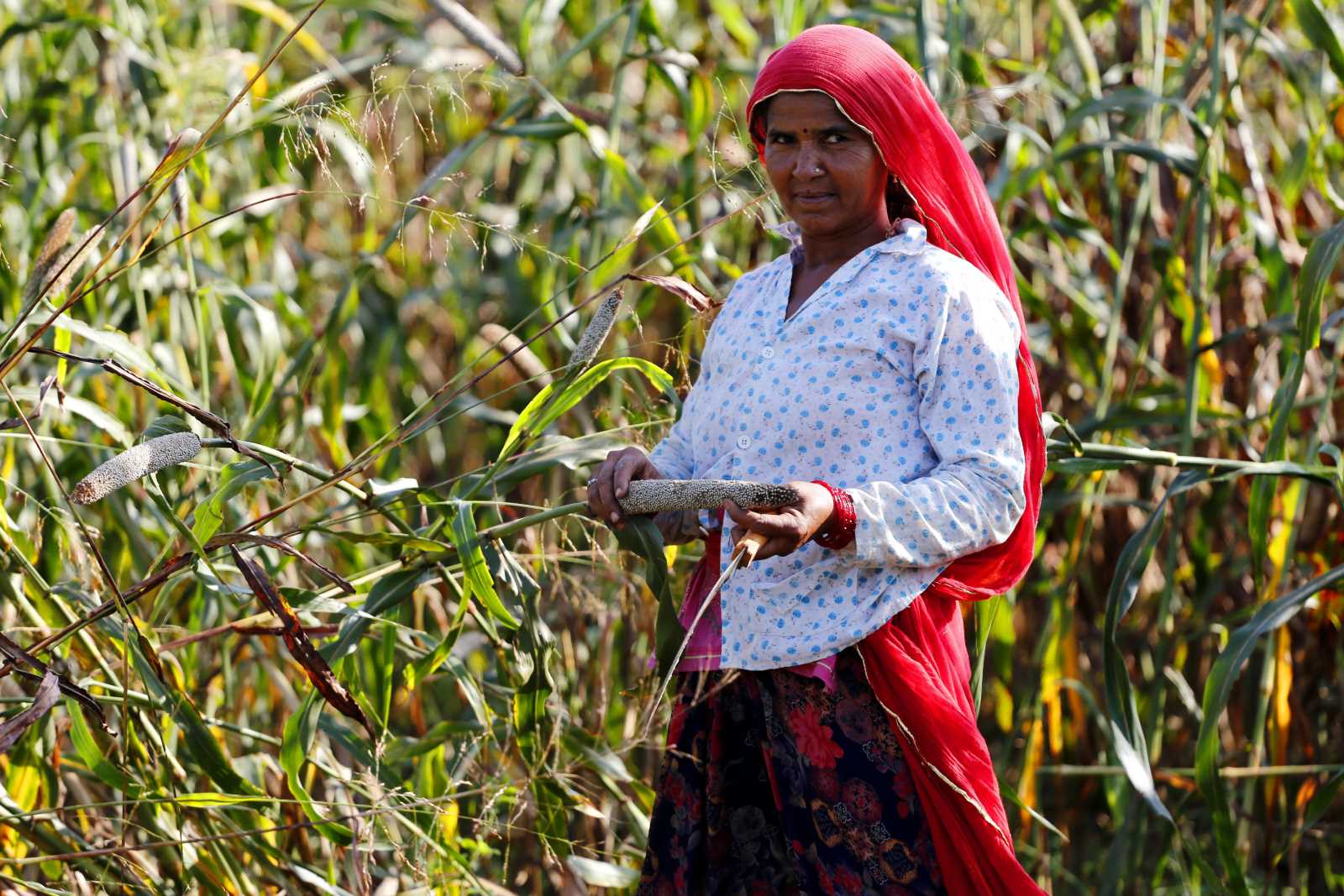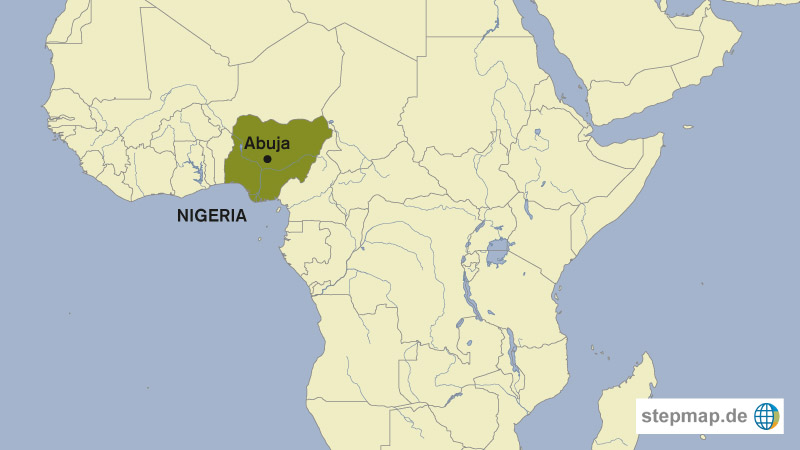Human and animal health
The animals die first

Millions of people in the Horn of Africa face major challenges from drought and shortage of water. And their animals need water too. More than 20 million people in the region live as pastoralists – nomadic herders – because arable farming is barely possible in this arid and semi-arid region. The people have no permanent home, moving around with their herds in search of water and pasture. Their livestock tend to be camels, cattle, goats or sheep.
Water points are vitally important for nomads. If livestock die for lack of water, the lives of the people who depend on them are immediately at risk. The latest drought in the Horn of Africa clearly shows that, when animals start dying, human deaths soon follow.
Animals do not die only of thirst, however. Among the consequences of too little water is a weakened immune system. Moreover, where water becomes scarce, there soon will be no grazing land. The animals become weak and undernourished – easy targets for parasites and infectious diseases. Such diseases, moreover, are transmitted faster from one animal to another because of the crowding that occurs at the few available water points.
Another impact of water shortage is that herds yield less milk because the animals lack the energy needed to produce it. An important source of human nutrition is thus lost. For children under five, in particular, wholesome vitamin-rich goat or camel milk is vital.
Some human diseases are typically prevalent in areas that are hit by shortage of water. Trachoma is one example. This eye disease is caused by bacterial infection (see D+C/E+Z e-Paper 2017/06). It is the reason of the blindness or visual impairment of nearly two million people. Trachoma is the world’s biggest infectious cause of blindness. It spreads fastest where hygiene is poor, e.g. where soiled towels are used by several people – a practice which is common where water is in short supply.
The disease is also transmitted by flies, which in turn tend to be around livestock a lot. Separated water points for humans and animals can help reducing the transmission of the disease.
Changing environmental conditions
Lack of rain changes the environment, and so do violent storms that cause flooding. In many places, extreme weather is increasing the risk of certain diseases for humans and animals. Such diseases may lurk, for instance, in soils that were impoverished by drought. Seeking nourishment from sparse blades of grass, animals graze closer to the ground and scuff the surface with their hooves. Doing so can expose them to the deadly threat of anthrax.
Anthrax made world headlines in 2001 when it was used in mail attacks in the United States. Letters containing anthrax spores were sent to a number of senators and news media offices. The bacterium that causes the disease is called bacillus anthracis. It produces a lethal toxin, which lends itself to use as a biological weapon. Animals infected with anthrax typically die suddenly with no previously discernible symptoms. The danger for livestock owners arises when animal carcasses are processed, for instance, to get the hides for leather. The risk of infection is very high because anthrax is a zoonosis, a disease that can naturally be transmitted from animals to humans.
An awareness of the role played by water – both as a giver of life, but also as a potential reservoir of germs that cause illness in both animals and human beings – is essential for any broad-based integrated approach for identifying health risks. This does not only apply to the world’s estimated 500 million pastoralists, but also the millions of smallholders and backyard animal farmers who live in close contact with livestock.
Cryptosporidium parvum is a protozoan that is dangerous for both humans and animals. Transmitted by faecally contaminated water, it causes a disease known as cryptosporidiosis, the symptoms of which are watery diarrhoea and abdominal pain. It is likely to harm infants and people with a compromised immune system in particular. For AIDS patients, infections can become fatal. In East Africa and elsewhere, many water sources are used by both humans and animals. They are a potential transmission point, especially if children play in contaminated puddles or faeces enter the groundwater.
Animal urine in water or mud can also spread dangerous diseases. For example: leptospirosis, which is caused by corkscrew-shaped motile bacteria transmitted in the urine of infected mammals such as rats, dogs, mice and pigs. Although basically any mammal can be infected with leptospirosis, small mammals – especially rodents – are the main carriers worldwide.
The animals that carry the bacteria do not normally develop leptospirosis themselves. They excrete the germs in their urine, in some cases throughout their life. Humans can become infected through small skin wounds or via mucous membranes. The main source is contaminated water or mud. In mild cases, the sufferer may experience flu-like symptoms. But there are also severe infections, which result in jaundice, kidney failure or meningitis. Two to ten percent of untreated leptospirosis cases are fatal.
The occurrence of this zoonotic disease becomes more probably where humans and animals live close together and where unhygienic conditions encourage rodent infestations. The incidence often rises after sudden heavy rainfall followed by flooding and mud flows. Leptospirosis is a typical post-disaster disease. It should be on the radar of every health professional working in the area of water and sanitation or delivering humanitarian aid in emergency situations.
Vétérinaires sans Frontières Germany (VSFG) has long been committed to an integrated “One Health” approach that takes account of humans, animals and the environment. The organisation runs projects in East Africa designed to help people whose livelihoods depend on animal husbandry. Apart from animal health, the NGO also tackles issues such as food security, drought prevention, agriculture, water supply and sanitation.
One project area is Afar in Ethiopia, a semi-arid region the size of Ireland. With temperatures regularly exceeding 50° Celsius, it is the one of the hottest places on earth. The project objective is to safeguard water supply for people and animals. The means for doing so range from rehabilitating water points to constructing water collection basins and implementing soil protection measures so the ground retains moisture longer. Hygiene education and separating water points for human and animal use are dealt with too.
Cornelia Heine is an adviser on international animal health and pastoralism with Vétérinaires sans Frontières Germany.
cornelia.heine@togev.de













